Deposition of Mark D. Gottlieb - Part 1

A. Good morning. How are you?
A. Okay.
A. Okay.
A. I understand.
Q. We are solely here to obtain factual information that might relate to that disciplinary investigation. And, of course, except as it relates to the disciplinary investigation, obviously a lot of these questions are going to have to do with the criminal investigation, but we are not involved directly in the criminal investigation, only as it relates to the disciplinary matter.
A. Okay.
Q. Let me start off by just introducing - ask you to take a look at this and just introduce into evidence the Notice of Deposition and Subpoenas that we have issued in this case. I ask you to take a look at that and see if you recognize it and see if you received the Notices this and the Subpoenaes? (Plaintiff's Gottlieb Deposition Exhibit Number 1 Marked.)
Q. Okay. Any objection to the Notice you were given as far as having enough time to prepare and anything like that?
A. The only thing I wanted to clarify was we received that thing asking for all of our records pretty much at the last moment. And we are more than happy to cooperate in any way we can to get you those documents, but we literally had a full file cabinet full of documents, and I believe your investigators are going over to look at that during the same time that we're doing this rather than bringing it here.
A. Right.
A. Right.
Q. Once the criminal matter was dismissed, we served the subsequent subpoena for the investigative file.
A. Yes, sir.
A. Right.
A. Yes.
A. That's fine.
Q. Just to make it a lot easier so you'll understand my questions. And, on that line, if there are any questions that I ask you that you don't understand, I want you to stop me and tell you don't understand them and ask me to clarify and I will be glad to try to explain what I am asking for.
A. Okay.
Q. If you need any breaks, just let me know, I will be glad to give you any breaks you want. I don't want to get into too much personal, but I do need to ask you whether there are any medical conditions that you have today that would prevent you from listening to the questions I ask and giving accurate and truthful answers?
A. No.
A. Okay.
Q. Are you taking any kind of medicationstoday that would prevent you from listening to my questions and giving me truthful and accurate answers?
A. I take a lot of medications, but nothingthat would prevent me from that.
Q. Okay, all right. Since I can't actually see it, I want to talk a little bit about the subpoenaed documentation. We had asked for, essentially, the complete investigative file for the Duke lacrosse cases. Can you explain to me in general terms what the documentation is that is at the second district that is being reviewed? In broad terms, what does it encompass?
A. In broad terms, it encompasses fullinvestigative notes, handwritten and computer documented things. Patrol investigative notes, correspondences, scientific report. some documents to and from, I believe, the District Attorney's office. And it's just a very regular report: search warrants, court orders, photography, forensic reports from the Durham Police Department. And a lot of it was organized, I would say, after the time frame where I had privy to see it, so those aren't things that I actually have looked at.
Q. Explain that last point as far as being organized after you had privy to it. I'm not sure I know what you mean.
A. It is a huge file.
Q. Okay.
A. Investigator Himan has done an excellent job of getting everything categorized, putting it in binders and things of that nature. A lot of it had started to actually be put in files to where it could be viewed clearly without having to try to figure out what you are looking at, because it's his investigation. At the time or just at the time that the Attorney General's office took the case, or once the Attorney General's office took the case, just to keep there from being any leaks, or whatever, basically the only conversations there were from Investigator Himan were to Captain Lamb. I was taken out of the picture along with everyone else in the Department, including the Chief, et cetera, because they didn't want it to be said -- there were so many -- things would come up everywhere during this investigation, and we didn't want it to be said that there were any leaks coming from us. So I wasn't looking at things and I wasn't reviewing things.
Q. When did that happen?
A. Just about the time the Attorney General took over.
Q. Okay. Was that before or after they assumed responsibility?
A. I would think after.
A. Yes.
Q. It contains matters pursuant to your orother individuals' duties as police officers investigating those cases?
A. Absolutely.
A. Yes.
MR. BROCKER: Dudley, so we can hopefully short circuit future proceedings, I just want to see if you will stipulate documents produced that we have designated for copying by the Durham Police Department would constitute public records and reports? Rather than going -- here's what I am trying to avoid, I'm trying to avoid having to go through every single document that we get from either Sergeant Gottlieb or Investigator Himan and say -
MR. WITT: Can we go off the record for just a second?
MR. BROCKER: Sure. (Discussion off the record.)
Q. (BY MR. BROCKER) Investigator Gottlieb,the records that are being -- the file that's being reviewed right now, we are likely going to designate certain things that we would ask the Department to copy and produce to both us and to Mr. Nifong's counsel from the investigative file that you have made available to us. Would it be accurate to say that any of the documents that you are going to produce, that you would copy and produce to us, would fit within the questions that I was just asking about, whether or not they had been generated during the course of the investigation, whether or not they set forth youractivities in those series of questions I just got finished asking you, is that accurate?
.
A. In '99 I believe I went to domesticviolence as an investigator there. Subsequently at some point, I became an investigator in the violent crimes unit. I was promoted and was made a corporal in the violent crimes unit. I wound up going back to patrol as a corporal until I started out as an acting sergeant whena sergeant was out that I had worked for and was promoted to a fall sergeant almost two years ago. And I went from sergeant in uniform patrol to a sergeant in the Criminal Investigations Division.
A. About two weeks before the Duke lacrosse case.
Q. Roughly March of 2006, the first part of March?
A. It was the very end of February, because I started out my first week as the on-call sergeant in investigations.
Q. Okay.
A. And as far as a paramedic, I've workedas a paramedic full-time and part-time up until about, I don't know, about two years ago, so it's been 25 years as a paramedic, roughly.
Q. All right. I am going to ask you aboutthe specific activities, but tell me -- give me an overview of your involvement in the Duke lacrosse
cases.
A. In the Duke lacrosse case, I was a supervisor over District 2 Investigations, Investigator Himan worked for me. I assigned the case to him. If he needed help, I would help him. otherwise, the case was his. I helped him prepare documents, I helped him locate some people. I helped him -- well, I didn't help him, I went out to search warrants because I am required to go out for search warrants as a supervisor just to make sure things go okay. Other than that, that's -- I did -- I would watch the newspapers, I would look at the blogs and things like that, anything that could give us a potential clue and tell Ben, Investigator Himan, what was going on that I had noticed. And if there were things he needed organized that were outside the realm of his control, I would assist him with that. One of my main functions was the act as a liaison between the investigation and the command staff to let them know what was going on.
A. The command staff would include the Chief, the Deputy Chief, the Majors, the Captain, the Lieutenant.
A. Lieutenant Ripberger was my directsupervisor at District 2, Captain Lamb is my direct Captain. Lieutenant Peter is a lieutenant over Criminal Investigations. And at the time of this investigation, Captain LaVarge, who is now retired, wasa Captain over Investigations. So even though I don't necessarily answer directly to them, they may or may not have some involvement because different areas kind of interact. For example, if we were using the Forensics Division, the Forensics Division is directly under the criminal Investigations, which would be Captain LaVarge and Lieutenant Peter. Whereas, if it dealt with a district investigative issue, then that would be Captain Lamb and Lieutenant Ripberger. As far as Majors, we have Major Council, Major Russ, Major Beerstrom and Major (Mahiage). Deputy Chief Hodge, Chief Chalmers. And then there were several other people from a high-ranking positions across the community who would sit in on some of these meetings. And that would be people from the Duke Police Department, their Police Chief. or I guess it's -- I don't even know what his exact title is. Some of the command staff, I'm not sure what their names are, from Duke. The City Manager, people like that.
A. The District Attorney's office has been called to a briefing before, yes.
Q. On these cases?
A. Mr. Nifong.
Q. Did he actually attend himself?
A. Yes.
A. That was after a photo presentation wasdone and the media and the defense attorneys made allegations, I guess, to the media that the photo presentation wasn't within policy, and Mr. Nifong was called and basically cleared up any questions for command staff.
Q. And when was that meeting, that briefing?
A. Honestly, sir, I don't know the date. I can tell you it was after the presentation was done.
A. I believe so, yes.
Q. I will ask you to take a look at, just for the record it's marked as Exhibit 204.
MR. BROCKER: Margaret, I don't think I asked you to, but would you mark the Notice and Subpoenas as Exhibit 1? (Plaintiff's Gottlieb Deposition Exhibits Number 204 Marked.)
Q. It's got two sets of numbers on it. The first set of numbers in the center goes pages 1 through 33. And then there's some un-numbered pages in the back. And it has hand written numbers on the lower right-hand side that go from 1815 through 1850. When you have had a chance to look at that, let me know, and then I want to ask some questions generally about it.
A. Yes.
Q. Do you recognize Exhibit 204?
A. Yes.
MR. WITT: For purposes of the record, are you going to keep -- we're just going to deal with it on this exhibit, we are not going to go, 1, 2, and 3 for the deposition? Because, I take it, it would be easier to track these as trial exhibits?
MR. BROCKER: Let's just go off for a second. (Discussion held off the record.)
A. Yes, sir.
A. This is documentation that I prepared.
Q. Okay. And it is entitled "Supplemental Case Notes for" you?
A. Yes.
Q. Are these your notes from the investigation of the Duke lacrosse cases?
A. Yes, they are.
Q. And is it, at least up through Page, I'll use the handwritten numbers, 1847, the last typewritten page ---
A. Oh, I see. Yes, sir.
Q. Can you tell from looking at it whether or not that is a complete set of your typewritten notes from the Duke lacrosse cases?
A. Yes, I believe it is.
Q. If as we are going through this you discover that it's not, just let me know?
A. Yes.
Q. I realize I'm asking you to look at over 30 pages of documents.
A. There may be something, maybe one or two paragraphs, after the fact that were added in, but those should be in the complete case files that Investigator Himan has locked in his file cabinet.
Q. Okay. Is that part of the materials that have been provided today that they are reviewing?
A. Yes. I'm sorry.
Q. Okay.
A. And that might just be that I received a phone call from this person or I received a phone call from that person, but that would be it.
Q. All right. Tell me what would be the last -- if you go behind that, Page 1848, those are some handwritten notes. can you tell me if you recognize those and, if so, what they are?
A. Yes, they are my notes. Basically, Idid some research to try to figure out if it was possible to send hair samples off to different companies to do testing for drug analysis.
Q. Okay.
A. That's it.
Q. All right.
A. It's basically just research.
Q. That is Page 1848.
A. Uh-huh (yes).
Q. Is the next page a continuation of that or is it something different?
A. It's all continuation.
Q. And then the last page, 1850, tell me what that is.
A. Now, the top thing with Rob Lang,federal prosecutor, is not a part for the part for the hair analysis, that was just a question I had for him about a case in Washington.
A. Trying to get some documents for Mr.Finnerty.
Q. Okay. And then the last page, 1850, tell me what that is.
A. This is an e-mail from Richard Clayton to me, and he sent that to me, and then I spoke with Investigator Himan. She denied that this took place and doesn't know where the cousin is getting that information from.
Q. Okay. It appears from reading it thatthere was some statement or insinuation from one of Ms. Mangum's family member that there had been an attempt to pay her off and then you spoke to her?
Q. You didn't. Okay. She spoke to Investigator Himan?
Q. And are these your notes --
A. Yeah.
A. Yes, sir.
MR. HILL: Do the best you can to let him finish. It's natural in conversation. But let him finish. He'll let you'll finish your answer. Because the court reporter is going to have a hard time getting you guys both down. Okay?
A. I believe I had wrote like a date or atime on different documents. But as far as me taking notes, I really wasn't doing an investigation. So, no, I didn't take handwritten notes. I was acting as a supervisor just trying to coordinate things. And the things that I had done when Ben had asked me to interview one player, the thing that I did was I told or asked Investigator Soucie would you take notes for me. so Investigator Soucie sat in on an interview and took notes for me during an interview.
A. Yes.
Q. So they are in the documentation that has been provided?
A. Yes.
Q. Do you know how we would find that easily within how it is organized in the file?
A. Looking at the search warrants and returns. For example, if I signed off a return on a search warrant, my name and date and time would be on it.
Q. So it would be within the rest of the documentation? What I'm asking is --
Q. Just individually on the documents as you went along?
A. Yes, sir.
Q. I take it then there are not separate notes like you'd have, for example, a legal pad where you had written out things that happened?
A. No, sir.
Q. Okay.
A. This are the extent of my notes. I would hand things to Investigator Himan, and he would file them. I did take notes to organize myself and to help Investigator Himan organize the investigation just on my board. And I have a board in my office, it's a, dry-erase board. And, for example, Investigator Himan would say, "I need to have someone look at different things, how we can get a hair analysis done," And I would put my name next to that. And then he'd say, "I need a background done for this person." I would assign someone to do that if he wasn't going to do it. He'd say, "I need a court order to get e-mail records," put his name next to that, et cetera,
et cetera, et cetera. I had asked him and was under the impression that he was taking photographs of the board, and when we finished that we would clear it. That wasn't done. And I apologize for that. But it wasn't things that gave an outcome per se, it was just an organizational checklist. Do this, this, this, this .
A. Absolutely not. Investigator Himan was keeping the notes. I wasn't there as an investigator. I was there, one, as a witness because we did it in her house; two, to give him advice if there were something that he needed advice on. It was his investigation. And for anything else that happened to come up. She had made claims that she had bruising. I asked Investigator Himan if he wanted ID to respond to take photographs of that bruising to show a progression of the injury and the bruising. He said "yes." I called for ID to come out and do that. That is basically it.
A. By reviewing the written notes and by my memory.
Q. Okay. The written notes you are referring to are --
Q. Himan's notes?
A. Yes.
Q. And when did you prepare the typed version of Exhibit 204?
A. Part of it was done initially, part of it was done afterwards. It's whenever I had time. he part about Ms. Mangum's interview was actually done just prior to it being turned in.
A. The interview with Ms. Mangum.
Q. On the 16th of March?
Q. So did you have a document on a computerthat you kept certain notes of? Like let's look at, to get specific, the first page of that, 3/15/06, your first contact about that.
A. Oh, okay.
A. It's kind of confusing because there were typewritten notes that were made up very early on in the case, and that was a typewritten document for - we were ordered to put something together for the City Manager to review to give a presentation to City council. And when I prepared that section, we went through and actually deleted almost all of it. It got down to a point to where it didn't say anything, and that is what was finally turned in.
Q. Okay.
A. But if you look -- and you had asked me earlier who else was in the meeting. I have Durham Police Command Staff, Duke Command Staff, City Manager and police legal advisor had also attended some of the meetings.
MR. HILL: Bottom of typed page 10, typewritten, or handwritten 1824, for the record. What are you looking for?
Q. Which document are you referring to, Sergeant Gottlieb?
A. It's a document prepared for the Command staff to present to the city Manager.
Q. And you are saying that was the first time that you started to put down into typewritten form the activities that you had been involved in in the Duke lacrosse cases?
A. Yes.
Q. Are you talking about a meeting? Just try to help out here. Are you talking about a meeting in which you were asked to prepare a time line for a presentation?
Q. I probably can -- I might be able tohelp you with that, if that is what you are looking for. If you look at Page 1839, I am looking at the handwritten numbers here on the right-hand side, it is after the description of the photographic presentation to Ms. Mangum on the 4th. If you go over to 1840, at the top of that page it says, "I paged Investigator Himan, who was at in-service training, and pulled him out of class to begin to work on this project."
A. Uh-huh (yes).
Q. --- it talks about preparing a timeline. Is that what you were referring to?
A. Yes.
Q. All right. And so does that help you remember when you would have first started to prepare the typewritten notes there that are in Exhibit 204?
A. I would say that it was at that time. Although, all of this, meaning 1827, was done prior to that.
Q. Okay. Page 1827 is the descriptive, basically, as you go through ---
Q. Yes, sir.
A. Yes.
A. 1827 is a descriptor of the Power Point presentation.
A. After the presentation, because I had to listen to the video over and over and over, line by line, to get the complete details.
Q. Okay. And as I understand, that happened, if you are looking at your notes, on the 4th of April.
A. Uh-huh (yes).
Q. Is that correct?
A. Yes, sir.
Q. And then the request from the Captain Lamb and Lieutenant Ripberger for the time line was later that same day? If you look down to typed Page 25 there?
A. Yes.
Q. So that description from the Power Point presentation would have been done some time after that request?
A. Yes.
Q. Up to that point, up until April 4th, had you prepared any typewritten notes of your investigation up through that day, the activities that came before that?
A. I am not sure, I don't know.
Q. Do you recall when you went back and typed in the entries for your first initial contact on the 15th of March?
A. That was after the indictment, I believe. Are you talking about from Buffy Jones?
Q. Uh-huh (yes).
A. Yeah. That was done in full after that,but that was in the time line also.
Q. Let me see if I am understanding you. From the 15th of 2006, March 15, 2006, through this meeting on April 4th where you were asked to prepare a time line for the City Manager, you had not kept typewritten notes of the investigation up to that. The ones that we now see here they didn't exist on the 4th.
Q. And then did I understand you that at that point when you were asked for a time line, you started preparing a typed document of a time line for this specific request?
Q. That document, I take it, is -- well, let me ask you. Is that a different document than the typewritten notes that we are looking at right now?
Q. And is that also part of theinvestigative file?
Q. And what I am still a little unclear about is from that point how do we get to having a complete set of supplemental case notes? we've got the time line that is prepared and then at some point after that the supplemental case notes, typed notes, you prepared those?
A. Yes.
Q. When was that done?
A. I don't know exactly when.
Q. After that point, after the 4th of April?
.
A. The case -- I never took handwritten notes, per se. I kept track of my activities by radio log. Meaning, if I stopped at somebody's house, I called in to police dispatch. If I was doing something, I called in to police dispatch for that. If I went out to Duke to assist them, I would call in to police dispatch, keeping track of that. Again, this is Ben's operation. This is pretty much something that Ben is responsible for keeping up with the case. I'm there as his supervisor, and I wasn't keeping up with the notes as far as that goes.
A. I don't understand what you are asking.
Q. After the 4th, for example, there are some activities here on April the 6th, Himan, page 27 of the typewritten notes.
A. Uh-huh (yes).
Q. Investigator Himan asked you to do an interview with Jarriel Johnson?
A. Right.
Q. The question I'm trying to ask is on April 6, 2006, did you then go back to the District andtype up the notes the same day of the interview or did you do it some time later?
A. No, I didn't need to, Investigator Soucie was keeping handwritten notes for me, and I typed it up later when I had time.
THE WITNESS: Very little was done the day anything happened, other than maybe phone calls.
Q. Okay. And was it predominantly -- thenotes that are contained in Exhibit 204, was it predominately prepared contemporaneously or shortly before you turned it over to the District Attorney's office?
A. When you say you are saying "contemporaneously," and I apologize if I sound argumentative, I am not understanding. When you are saying "contemporaneous," I think of that as handwritten notes. No?
Q. No. All I'm asking -- what I'm tryingto get a handle on is when the vast majority of the notes -- I don't really want us to have to go through each individual note, that will take a very long time.
A. My answer would be I don't know. I amnot saying that to -- I'm not saying that to make light of the situation. I just don't know. Half of it was done before, like midway. You know, for example, if you want to talk about half of this thing, more than half of it is this thing from April 4th, which was the majority of what I did. My role in the investigation was very little as far actually doing any investigative stuff. Things that I did along the way other than that, Investigator Himan had his notes, I had Investigator soucie for the one interview I conducted keep notes for me so I could go back and do it then. I mean, I 'll be happy to say I sat down and went through all my typed notes the last week when I was turning it in, going through e-mails, going through what I could see in the file, and trying tomake sure that everything was complete and accurate before it was turned in. I did a lot of typing during that last week. But as far as what I typed that last week and what was typed before, I do not know.
Q. Okay.
A. And that's -- I typed this shortly after I was done. I turned this in to Mr. Nifong as soon as I could because Mr. Nifong had to give his report to the defense attorneys. That was long before anything happened. So this would have been April, I believe. The PowerPoint, Investigator Soucie -- office. (Witness reads to himself.)
Q. Okay. Were you referring to -- just now, you were referring to --- type that?
Q. Okay.
Q. Okay. And that --
A. This, this entire Power Point presentation was turned in very early in the investigation because this was required very early in the investigation for the -- I'm trying to think of the name of the -- the non-testimonial. This is the report, basically, for the non-testimonial. So this had to be turned in at the earliest time. So.
Q. Okay. so you are talking about what is now the typewritten pages, pages 13 through 25, which is your summary of the Power Point presentation.
A. Uh-huh (yes).
Q. Is that right?
A. Uh-huh (yes).
Q. That's what you are referring to.
A. Uh-huh (yes).
Q. So that is something that was done earlier?
A. Yes.
Q. And was it in a separate document that you had prepared and then incorporated into this case note?
A. I believe part of it was. Part of it was typed -- and, again, if you are talking about 204 itself, then, yes. But part of it was also typed up and then erased as part of the thing that was turned over to the City Manager.
Q. The time line?
A. Yes.
Q. And would the Exhibit 204 have been finalized and turned over to Mr. Nifong sometime after June 30th of '06?
A. Yes.
Q. That's the last entry.
A. Yes.
Q. Okay. And had Mr. Nifong requested that you prepare case notes which became Exhibit 204?
A. Yes.
Q. Do you know when he made that request?
A. I have no idea.
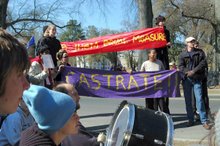




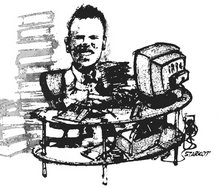
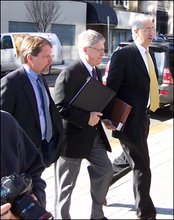
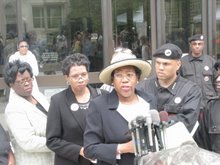
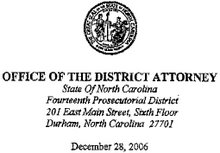
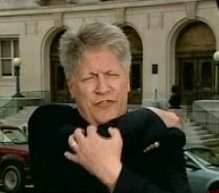

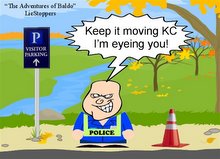

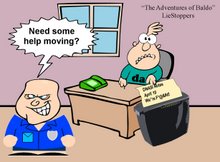

















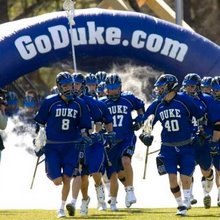

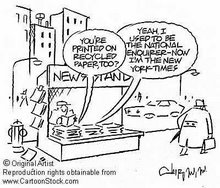

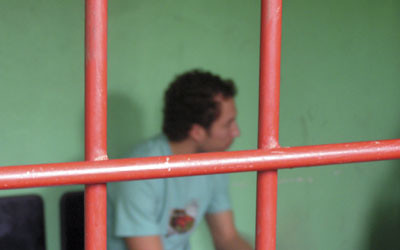
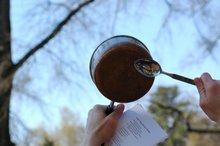

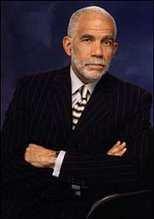
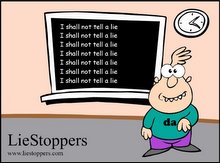






2 comments:
It looks to me that Gottlieb lied his butt off in that deposition.
He stabbed Himan in the back, as we know the evidence shows Gottlieb was central in this case. It's laughable for him to contend otherwise.
Thanks Liestoppers!
And this idiot is an officer of the law - and at one time was an EMT in the same area??? God forbid is Gottlieb is the "typical" officer that is a member of the DPD. The state AG/Feds need to look at not just the DA's office, but the DPD for their shoddy police work.
Post a Comment